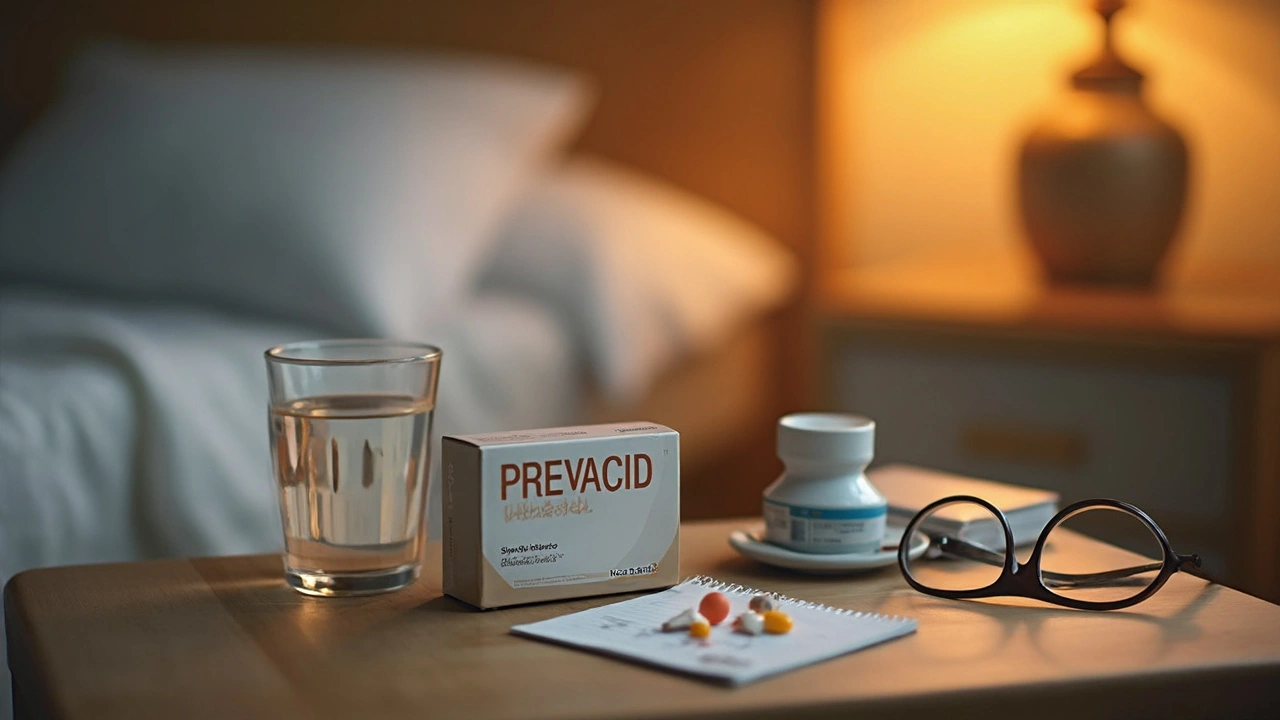Ever wake up in the middle of the night with that awful burn creeping up your throat? Yeah, acid reflux is the worst. If you’re grabbing for antacids way too much, you’ve probably heard of Prevacid. But is it a miracle pill, or just another quick fix? Let’s pull back the curtain and get honest about what Prevacid really does—and what you need to know before it lands in your medicine cabinet.
What Exactly Is Prevacid and Why Do People Use It?
Prevacid isn’t some mysterious new drug pulled out of nowhere. Its main ingredient is lansoprazole, which falls under the group called proton pump inhibitors (or PPIs if you hate long words). Basically, it lowers the amount of acid your stomach makes. So if you’ve got heartburn, acid reflux, or those fiery bouts of indigestion that make you fear pizza night, this pill tries to give your stomach a break. You’ll see Prevacid prescribed for things like chronic GERD (gastroesophageal reflux disease), stomach ulcers, and even conditions like Zollinger-Ellison syndrome. That last one’s rare, but it’s a disorder where your stomach pumps out way too much acid.
The science here is kind of neat—when you pop a Prevacid capsule or chewable tablet, it switches off parts of the stomach’s acid machinery. There’s a protein in your stomach lining (the proton pump), and Prevacid tells it to chill out. Unlike straight-up antacids that just neutralize what’s already there, this stuff keeps new acid from being made in the first place.
The FDA approved Prevacid back in 1995, and now there are over-the-counter versions as well. You’ll find it sold in 15 mg and 30 mg options, either by prescription or just sitting on pharmacy shelves. Doctors sometimes recommend it for two weeks in a row if you’re using the OTC version—no longer unless your doctor really wants you to. Some studies show nearly 60% of chronic reflux patients get symptom relief from regular daily Prevacid use, so it’s clearly more than just hype. But that doesn’t mean it’s without quirks.
How to Take Prevacid: Dosage, Timing, and Myths
There’s this running joke online that people toss pills into their mouths the same way they do peanut M&Ms—no instructions, just vibes. With Prevacid, a little planning helps. Your doctor will usually start you off with a 15 mg or 30 mg capsule once daily, depending on your symptoms. If you’re tackling chronic heartburn, it’s usually one tablet taken before eating, preferably in the morning. Food can reduce absorption, so taking it on an empty stomach is the way to go.
If you’re dealing with stubborn ulcers or healing up after a nasty stomach infection (think H. pylori), your doctor might pair Prevacid with antibiotics. The regimen looks a little like a mini boot camp for your gut: Prevacid plus two antibiotics, twice a day, typically for a week or two. Some folks are treated for longer stretches if their stomach is just not cooperating.
Using the oral disintegrating tablet? Don’t chew or swallow it whole. Let it melt on your tongue, like a breath mint you can actually brag about. If you have trouble swallowing capsules, you can open one and sprinkle the contents on applesauce—just avoid hot liquids, which ruin its effectiveness. Never crush or chew the tiny granules themselves; they have a special coating to survive stomach acid long enough to work where they’re supposed to.
Mistakes happen, though. If you forget a dose, take it as soon as you remember unless it’s almost time for your next one—then just skip, don’t double up. Overdosing on Prevacid isn’t common, but you could end up with confusion, drowsiness, or a racing heartbeat. If that happens, get help (and next time, set a reminder on your phone).

Prevacid’s Benefits—But Also Its Limits
Prevacid’s biggest claim to fame is how reliably it calms down heartburn and those angry-feeling reflux attacks. Clinical studies back this up: in controlled trials, two out of three folks with severe reflux said they felt real improvement within a week. Give it two weeks, and up to 80% are living life without reaching for antacids after every meal.
But there’s a catch—Prevacid doesn’t work instantly. This isn’t a fast-acting relief like chewing a chalky antacid. You’ll need at least a few days before things really settle down, because it’s changing how your stomach does business at the source.
It’s not all about heartburn either. Prevacid helps heal peptic ulcers (those miserable sores in your gut), especially ones caused by regular use of NSAID painkillers or H. pylori. You might also see your doctor prescribe it for preventing future ulcers if you’re stuck taking anti-inflammatories long-term. There’s even some off-label use in limiting acid exposure from tube feeding or after certain surgeries. If you’ve got a beagle like Nemo who tends to sneak snacks off the counter that send your heartburn through the roof, well—Prevacid won’t stop the beagle, but it might help with your stomach’s protest.
Let’s talk about long-term use. Prevacid isn’t meant to be your daily crutch forever. Taken every now and then, it’s safe for most people, but long-term use can mess with how you absorb nutrients like magnesium, calcium, and vitamin B12. There’s some data showing a slight uptick in risk for hip fractures in older adults who stick with PPIs for years. That’s not to scare you; it’s just to remind you not to self-prescribe these for months on end without a doctor’s say-so.
Prevacid also isn’t a magic bullet for every type of digestive pain. If you’ve got symptoms that seem weird or severe—trouble swallowing, unexplained weight loss, black or bloody stools—you need to talk to a doctor ASAP. Prevacid can mask some big warning signs, so don’t let it lull you into ignoring something serious.
| Condition | Typical Prevacid Dosage | Treatment Duration |
|---|---|---|
| Heartburn/GERD | 15-30 mg once daily | 14 days (OTC) |
| Stomach ulcers | 15-30 mg daily | 4-8 weeks |
| H. pylori infection | 30 mg twice daily (plus antibiotics) | 10-14 days |
| Prevention (NSAIDs users) | 15-30 mg daily | As needed |
Side Effects, Warnings, and How to Stay Safe
Pop any pill and there’s always the fine print. For Prevacid, side effects are usually mild. You might get a headache, tummy pain, or a little nausea. Rarely, people complain about diarrhea or constipation. Dry mouth and dizziness show up in maybe 2% of users, based on numbers from real-world patient reports.
The bigger problems pop up with long-term or high-dose use. Prevacid can mess with your magnesium levels. If you get muscle cramps, irregular heartbeats, or feel super weak, get checked—low magnesium is sneaky but serious. Taking Prevacid for years might blunt your body’s ability to absorb vitamin B12, setting you up for fatigue and nerve issues down the road.
There’s also a rare but possible risk of certain stomach infections. Your gut acid defends against bad bacteria, so suppressing it for a long time might open the door to infections like C. diff, which causes severe diarrhea. One real-life tip: stay hydrated and call your doc if you get unrelenting diarrhea that won’t quit.
Drug interactions? Oh, absolutely. Prevacid makes your stomach less acidic, which can mess with how your body absorbs some meds. Drugs like ketoconazole, digoxin, and even iron supplements might not play nice, so always check with your doctor or pharmacist when you’re mixing meds—especially if you’re already juggling prescriptions daily. People on blood thinners like warfarin need to be extra watchful, since PPIs can sometimes tweak how those meds act in your system.
One more thing: don’t stop Prevacid cold turkey after long-term use. You could get rebound acid production, which is basically your stomach going "Hey, where’s my suppression?" and pumping out extra acid. If you want to quit, your doctor will likely suggest a gradual step-down.

Tips, Tricks, and Real-Life Wisdom For Prevacid Users
If you’re not a fan of medicine routines (who is?), a few tweaks can help Prevacid work even better for you. First, try to take it at the same time every day, before breakfast. Your stomach’s acid pump is most active before you eat, so hit it then for max effect. Setting an alarm or linking it to your morning dog walk—if you’ve got a routine, like Nemo’s potty break—can make this habit stick.
Be patient. You won’t feel better overnight, so give Prevacid a few days to start working. If you’re still miserable after two weeks of over-the-counter use, or if symptoms come roaring back after you stop, circle back to your doctor. People with extra-tough cases might need a longer course or a different medication.
Tweak your meals to help out the medication. Big, heavy meals and late-night snacks are prime triggers for acid reflux. Try smaller, lighter meals and eat your last bite at least three hours before bed. Skip the spicy takeout and chocolate shakes if you know they set your chest on fire—even Nemo can’t help you there. Raise the head of your bed (or sleep on a wedge pillow) to keep that acid where it belongs during the night.
- Stick with water—alcohol, coffee, carbonated drinks, and juice can all make things worse for some folks.
- If you’re on Prevacid long term, ask your doctor about testing magnesium and B12 levels every so often.
- Avoid mixing Prevacid with antacids right away. Wait at least 30 minutes after Prevacid before chewing a Tums or taking other relief options, or they might mess up how your pill works.
- Store Prevacid in a dry place at room temperature. Humid bathrooms are the ultimate enemy of pills—moisture ruins them before you even notice.
- If you get new or unusual symptoms, don’t just wait it out. Sometimes a switch or check-in is the best move.
And one last nugget: Prevacid isn’t addictive, but your body can get used to having less acid over time. If your prescription says to use it "short term," don’t try to push for longer without chatting with your doc. Newer PPIs or different approaches might work better for you down the road. The real trick isn’t just getting rid of symptoms—but making sure you’re taking care of your body for the long haul. Nemo’s idea of self-care is a belly rub; for the rest of us, it’s a check-in with our healthcare team and a little detective work about what makes our guts happy. Probably with fewer table scraps, if you ask me.


Julia Odom
Thank you for such a comprehensive overview of Prevacid; the depth of information is truly commendable. The explanation of the mechanism of action was particularly illuminating, as many readers often conflate PPIs with simple antacids. It is crucial to emphasize the importance of taking the medication on an empty stomach to maximize absorption, a point you made with clarity. Your inclusion of dosage tables and the distinction between OTC and prescription strengths will certainly aid patients in making informed choices. Moreover, the caution regarding long‑term nutrient malabsorption underscores responsible usage. In short, your article balances scientific rigor with practical advice-a rare and valuable combination.